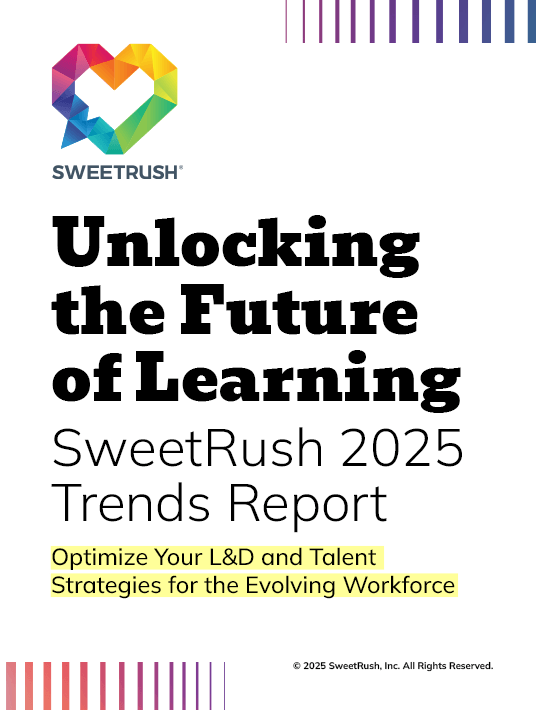Microimmersion: A Concise Approach To Learning With AR, VR, And MR
Transformation-minded L&D leaders are constantly looking to embed the most authentic, transferable, and effective learning opportunities throughout the employee lifecycle. Increasingly, these innovators are transforming their approach to flow-of-work learning with immersive technologies like Virtual Reality (VR), Augmented Reality (AR), and Mixed Reality (MR). In 2025, the industry is pushing the boundaries for more concise immersive learning experiences to be embedded in the flow of work for learners.

eBook Release
Unlocking The Future Of Learning: SweetRush 2025 Trends Report
Gain insights from SweetRush strategy experts to navigate change and build a future-ready workforce and business.
Download the eBook.
Immersive Learning As A Strategic Driver
VR, AR, and MR are powerful tools for creating engaging, realistic digital learning environments that increase learner engagement, accelerate knowledge and skill acquisition, and boost retention for the long term.
L&D innovators are leveraging these technologies for a wide range of use cases, from interpersonal to technical. These highly effective and engaging experiences enable learners to practice essential skills, navigate challenging situations, and deepen their understanding of roles within the organization at every stage of the employee experience.
Flow-Of-Work Immersion: Real-Life Applications
Immersive learning experiences can be tailored to specific roles, tasks, lengths, and stages of the employee lifecycle.
Below are a few real-life applications:
Augmented Reality (AR)—L&D leaders are using AR to overlay digital information on to the real world and offer employees real-time performance support. Accessible via smartphone or tablet, AR fosters efficiency, reduces errors, and empowers employees.
Virtual Reality (VR)—When learners need to practice a high-stakes skill, L&D leaders often choose to immerse them in a safe 3D digital practice space with VR. Learners access these spaces via a headset and view them instead of their real-life surroundings, filtering out distractions. WebXR, a browser-based immersive learning technology, allows learners without headsets to opt for a less-immersive but highly effective 2D experience. VR is incredibly effective for practicing performance-based tasks that involve risk to people, property, or relationships.
Mixed Reality (MR)—MR blends the physical and digital worlds, offering a rich, relevant, “phygital” experience. To access MR experiences, learners use headsets with see-through displays to interact with a digitally transformed version of their surroundings. MR opens up exciting possibilities for hands-on learning, collaboration, and flow-of-work performance support. For example, a medical professional might use MR to visualize and interact with a 3D beating heart, while a hazard response professional might practice cleaning up a simulated chemical spill at their worksite.
Renewed Focus With Microimmersive Learning
Immersive learning experiences speed up skill acquisition, boost engagement, and increase confidence. Industry research shows that learners engaged in VR training develop soft skills 4x faster than in traditional settings and are more confident in applying what they learned. Immersive learning also boosts retention and is estimated to be 52% more cost-effective at scale than eLearning experiences.
The Microimmersion Opportunity
Immersive learning shouldn’t be lengthy. Quick, real-time immersive experiences like Hilton’s innovative guest service training can help an employee upskill in minutes.
Microimmersive content also empowers L&D leaders to innovate with a shorter runway: By creating a common interaction flow, they can create numerous brief scenarios on incredibly ambitious timelines. From hospitality professionals interacting with a concerned guest to claims adjusters evaluating structural damage, these targeted microimmersive solutions condense immense content into a few minutes, thus empowering learning through the flow of work.
Three cognitive theories illustrate the value of VR, AR, and MR for learning:
- Embodied cognition: Body and mind are inseparable. When learners use their bodies and voices along with their minds in a 3D space, learning is greatly enhanced.
- Situated cognition: Knowing is inseparable from doing. Situating learners in simulated versions of the target social, cultural, and physical environment substantially enhances learning and knowledge transfer.
- Metacognition: Self-awareness promotes self-directed learning. Scaffolded immersive experiences with robust, real-time feedback allow learners to develop insight and metacognitive awareness.
Looking Ahead
In 2025, L&D leaders will continue to increase the ROI of learning strategies by strategically expanding the use of immersive learning. That will require a clear understanding of knowledge management, learning and business requirements, and technology capabilities. Providing concise and efficient immersive learning into the flow of work is a necessity for the modern workforce of 2025.
Discover additional strategies for skilling, knowledge management, and strategic workforce planning with Unlocking The Future Of Learning: SweetRush 2025 Trends Report. You’ll find ten key developments shaping L&D and talent in 2025 and beyond to build an agile, resilient, and productive workforce.

SweetRush
Our job is to help you achieve your objectives and be successful. Engage us at any point, from analysis to custom development (including e-learning, mobile, gamification, and ILT) to evaluation.

